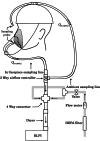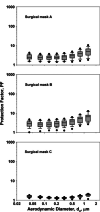Respiratory performance offered by N95 respirators and surgical masks: human subject evaluation with NaCl aerosol representing bacterial and viral particle size range
- PMID: 18326870
- PMCID: PMC7539566
- DOI: 10.1093/annhyg/men005
Respiratory performance offered by N95 respirators and surgical masks: human subject evaluation with NaCl aerosol representing bacterial and viral particle size range
Abstract
Objectives: This study aimed at determining the protection factors (PFs) provided by N95 filtering facepiece respirators and surgical masks against particles representing bacterial and viral size ranges (aerodynamic size: 0.04-1.3 mum).
Methods: The protection levels of N95 filtering facepiece respirators (four models) and surgical masks (three models) were investigated while they were donned by 12 subjects performing the OSHA (US Occupational Safety and Health Administration) fit-testing exercises in a test chamber.
Results: About 29% of N95 respirators and approximately 100% of surgical masks had PFs <10, which is the assigned PF designated for this type of respirator by the OSHA. On average, the PFs of N95 respirators were 8-12 times greater than those of surgical masks. The minimum PFs were observed in the size range of 0.04-0.2 mum. No significant difference in PF results was found between N95 respirators with and without an exhalation valve.
Conclusions: The study indicates that N95 filtering facepiece respirators may not achieve the expected protection level against bacteria and viruses. An exhalation valve on the N95 respirator does not affect the respiratory protection; it appears to be an appropriate alternative to reduce the breathing resistance.
Figures





References
-
- Balazy A, Toivola M, Reponen T, et al. Manikin-based performance evaluation of N95 filtering-facepiece respirators challenged with nanoparticles. Ann Occup Hyg. 2006;50:259–69. - PubMed
-
- Balazy A, Toivola M, Adhikari A, et al. Do N95 respirators provide 95% protection level against airborne viruses, and how adequate are surgical masks? Am J Infect Control. 2006;34:51–7. - PubMed
-
- Brosseau LM. Aerosol penetration behavior of respirator valves. Am Ind Hyg Assoc J. 1998;59:173–80. - PubMed
-
- Carrera M, Zandomeni RO, Fitzgibbon J, et al. Difference between the spore sizes of Bacillus anthracis and other Bacillus species. J Appl Microbiol. 2007;102:303–12. - PubMed
-
- CDC. CDC interim recommendations for protecting workers from exposure to Bacillus anthracis in work sites where mail is handled or processed. Atlanta, Georgia: Centers for Disease Control and Prevention; 2001. - PubMed
Publication types
MeSH terms
Grants and funding
LinkOut - more resources
Full Text Sources
Medical

